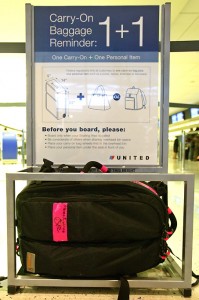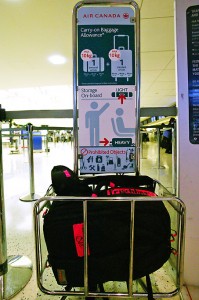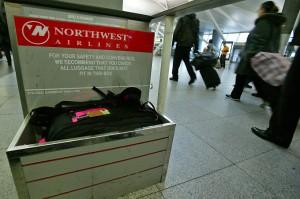Airline Carry-On Baggage Templates : Does Anyone Measure Them?
Web: www.stevenfrischling.com — E-Mail: fish@flyingwithfish.com
22/01/2009 – Airline Carry-On Baggage Templates : Does Anyone Measure Them?
Understanding carry-on baggage restrictions can be challenging, especially when you travel with bags that cannot be checked.
Most airlines currently use a semi-universal carry-on size policy, if weight is not a factor. For most major airlines, the carry-on baggage limit is 45-linear inches (114.3cm).  This sizing seems simple enough until you find out that the airlines do not use a standard format to arrive at 45-linear inches (114.3cm)
The lack of universal sizing for carry-on baggage becomes more complex when airlines introduce rigid carry-on baggage templates in airports.  A rigid template cannot be argued with, either your bag fits in the template, or it does not. These templates also give airline personnel the easy way out when telling you that your bag cannot be used as carry-on.
We all know airlines often do not have universal systems in place, but this problem becomes more of a hassle when transiting from on airline to another, even while flying on a ‘code-share’ or intra-Alliance flight.   The best example of this I can give is the difference in carry-on baggage sizing between close airline alliance partners United Airlines and Air Canada.
When flying United Airlines carry-on baggage dimensions are 9 x 14 x 22 in. (23 x 35 x 56 cm)
When flying on Air Canada carry-on baggage dimensions are 9″ x 15.5″ x 21.5″ (23 cm x 40 cm x 55 cm)
You can see that the numbers don’t match up; even mathematically they don’t match up. United Airlines’ carry-on allowance is 45-linear inches, while Air Canada’s carry-on allowance is 46-linear inches, although both airlines state the maximum carry-on size is 45-linear inches.  This problem only gets worse when you face having to place your bag in a rigid metal ‘box’ to see if your bag fits.
To make matters worse, the rigid metal templates, rarely match the actual size requirements.
When I place my GuraGear Kiboko backpack in a United Airlines baggage template, the bag slides in without any problems and has plenty of room within the template. When I place the same GuraGear Kiboko backpack in the Air Canada template (which should be 1″ larger than the United template) I have to push and squeeze the bag into the template.
So what can a flyer do to make sure their bag fits all carry-on baggage requirements? You can make sure your bags are all ‘international carry-on compliant.’  An international carry-on compliant bag is 45-linear inches (114 linear centimeters) including the wheels and handle of the bag.  I like to make sure my bag is slightly under the legal carry-on size allowance just in case there is a problem with the carry-on baggage template.
Pleading your case to a person can be done; pleading your case to an empty metal box under the disapproving eye of airline personnel is harder.
Below are photos of my GuraGear Kiboko backpack inside the baggage templates for United Airlines, Air Canada and Northwest/KLM.  You can see that the bag easily fits in the United and Northwest/KLM templates (both 45-linear inches) and that it is stuck in the Air Canada template (which should be 46 linear inches).





“Pleading your case to a person can be done; pleading your case to an empty metal box under the disapproving eye of airline personnel is harder.”
Which once again reminds us of the chasm between persons and airline personnel.
Thank you, thank you, I’ll be here all week.
It all depends on who you get. But yes, there are some airlines that have personnel that are known to be akin to speaking with a brick wall.
Airlines needs to start focusing on customer relations again…and I hope to write about that topic early next week in regard to a specific UK airline.
Happy Flying!
-Fish
Hi Fish;
Interesting when the Kiboko is supposed to be 8.5x14x21 inches (21.6 x 35.5 x 53.34 cm) or 43.5″ linear which means technically it should fit in any of them. Maybe I should add tape measure to my photo kit! 🙂
I ended up buying a Kiboko BTW… Air Canada is my home base airline. Hopefully they won’t hassle me every outbound I take!
Thanks for the update and happy flying to you also…
Allen…
I’m due to do another international move shortly, and so will be trying to somehow wangle all of my camera gear through the airline system. I have a nasty feeling I’m going to get abused again for having excess baggage…
Perfect timing for this post. You see that congressman from Illinois wants the gov’t to control the carry-on size for all airlines? http://www.theairlineblog.com/?p=1109 (heh, that pic might look familiar 🙂 )
I don’t think any airline really regulates these rules. They are probably there in case they need to use them. With all the baggage fees more and more people are pushing the limits with their carry-ons.
David
The Airline Blog
I use a Titan 19″ International carry-on and I never had any problem. Only in Europe where they have a 8kg weight requirement too on top of the dimensional restriction.
A way I have managed to navigate around certain airline weight restrictions is to use backpacks and developed style of carrying these backpacks that has better than a 90% success rate in avoiding gate weighing.
Happy Flying!
-Fish
I’m not sure where you got the 45 linear inches for carryons. Linear inch measurements are used for check-ins, not carryons. Carryons are an actual height-width-length measure so the bag will fit either under the seat or in the overhead. For most airlines the standard is 9 x 14 x 22.
Think about a linear measurement. An item 1″ x 5″ x 40″ meets the linear inch criteria, but would it fit under a seat?
32 year airline employee
Sue,
Which airline are you referring to? My carry-on requirements and template question comes from the airlines published carry on allowances. I had compiled a detailed list some time again at http://bagsize.notlong.com
Happy Flying!
-Fish